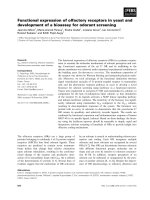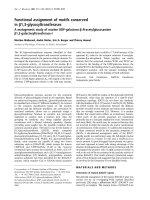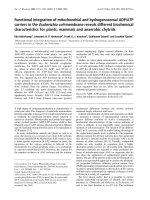Báo cáo y học: "Functional relevance of IL-10 promoter polymorphisms for sepsis development" docx
Bạn đang xem bản rút gọn của tài liệu. Xem và tải ngay bản đầy đủ của tài liệu tại đây (114.68 KB, 2 trang )
Dr Ling and colleagues performed a large prospective
study, including 308 patients with major trauma, and
determined that the genotype distribution of the IL-10
polymorphisms was associated with the sepsis morbidity
rate and multiple organ dysfunction syndrome (MODS)
scores [1]. e authors also investigated the association
of polymorphisms with lipopolysaccharide-induced IL-
10 production.
Cytokine production varies between individuals, due to
genetic background and certain allelic variants of cyto-
kine genes – in particular, SNPs are associated with higher
or lower cytokine production. e IL-10 5´-fl anking
region, which controls transcription, is polymorphic,
with two microsatellites and three SNPs (–1082, –819,
and –592) [2]. Polymorphisms in the regulatory region of
the IL-10 gene may infl uence its expression, and hence
could infl uence the susceptibility of sepsis [3].
e authors investigated the hypothesis that SNPs
located in the cis-regulatory region of IL-10 promoter
might represent a risk factor or a protective factor for
developing sepsis and might infl uence the MODS score
after major trauma. e results obtained by Dr Ling and
colleagues demonstrated that both the –1082A and
–592A alleles were signifi cantly associated with lower
lipopolysaccharide-induced IL-10 production in an
allele-dose-dependent fashion. In contrast, there was no
signifi cant diff erence for association between the –819
polymorphism and induced cytokine production. ese
results are in agreement with the data from Turner and
colleagues, who found that the IL-10 –1082A allele is
associated with lower in vitro IL-10 production by
concanavalin-A-stimulated peripheral blood mono nuclear
cells from normal subjects [2]. Moreover, Stanilova and
colleagues reported that carriage of at least one copy of
the IL-10 –1082A allele in sepsis patients as well as in
healthy controls resulted in a statistically signifi cant
decrease of IL-10 production from stimulated peripheral
blood mononuclear cells, regardless of the stimuli used
[4].
Altered host defense mechanisms are considered
important for the development of sepsis and septic shock.
Proinfl ammatory and anti-infl ammatory responses contri-
bute to the development and outcome of severe sepsis
[5]. Cytokines play a pivotal role in the regulation of the
type and magnitude of the immune response, and the
polymorphic nature of the cytokine genes may confer
fl exibility on the immune response. e gene encoding
IL-10 cytokine involved in the modulation of infl am-
matory responses as a main anti-infl ammatory agent is
therefore a candidate gene for determination of the
human genetic background, which is responsible for
inter individual diff erences in susceptibility to sepsis
development. Previous reports have indicated that
increased IL-10 production might be associated with the
susceptibility and outcome of the sepsis [6-8]. e
polymorphism at position –1082 in the promoter region
of the IL-10 gene has been studied by Shu and colleagues,
who reported an association of this polymorphism with
Abstract
The induced production of proin ammatory and
anti-in ammatory cytokines is considered important
for the development of sepsis and its sequelae.
Polymorphisms in the IL-10 gene promoter could
in uence its expression and sepsis susceptibility.
Results obtained by Dr Ling and colleagues
demonstrated that the –1082A allele was signi cantly
associated with lower lipopolysaccharide-induced
IL-10 production in an allele-dose-dependent fashion.
They also showed that this polymorphism was
signi cantly associated with sepsis development after
major trauma. These and other research data clearly
demonstrated that the –1082 A/G polymorphism in
the IL-10 gene promoter has an important impact on
susceptibility of sepsis and sepsis outcome.
© 2010 BioMed Central Ltd
Functional relevance of IL-10 promoter
polymorphisms for sepsis development
Spaska A Stanilova*
See related research by Zeng et al., />COMMENTARY
*Correspondence:
Department of Molecular Biology, Immunology & Medical Genetics, Faculty of
Medicine, Trakia University, Aremiska 11 str., Stara Zagora, Bulgaria
Stanilova Critical Care 2010, 14:119
/>© 2010 BioMed Central Ltd
susceptibility to severe sepsis – in contrast to the other
two linked IL-10 polymorphisms (–592 and –819) in the
same gene region [9]. Stanilova and colleagues showed that
the A allele of the –1082 polymorphism in the IL-10 gene
promoter is associated with sepsis susceptibility, whereas
the G allele is asso ciated with higher stimulated IL-10
production and increased mortality in severe sepsis [4].
Ling and colleagues also showed that, unlike the –1082
polymorphism, the –819 and –592 polymorphisms were
not signifi cantly associated with the sepsis morbidity rate
and MODS scores. ese collective data clearly
demonstrated that the –1082 A/G polymorphism in the
IL-10 gene has an important impact on susceptibility of
sepsis and sepsis outcome. is eff ect is due to the anti-
infl ammatory and immunoregulatory properties of IL-10.
e excess of IL-10 production in trauma patients or
other critically ill patients determined by the –1082G
allele could be responsible for inducing immuno-
suppression and subse quently developing bacterial sepsis
and MODS. e concentration of IL-10 in the blood – in
most respects, lipopolysaccharide-induced IL-10 – is
indicative for the magnitude of the infl ammatory stress
during sepsis and has been shown to correlate with both
the severity and outcome of sepsis.
Whether cytokine determination and genotyping in
critically ill patients could optimize treatment and sepsis
outcome should be determined by further randomized
studies.
Abbreviations
IL = interleukin; MODS = multiple organ dysfunction syndrome; SNP = single
nucleotide polymorphism.
Competing interests
The author declares that they have no competing interests.
Published: 15 February 2010
References
1. Zeng L, Gu W, Chen K, Jiang D, Zhang L, Du D, Hu P, Liu Q, Huang S, Jiang J:
Clinical relevance of the interleukin 10 promoter polymorphisms in
Chinese Han patients with major trauma: genetic association studies. Crit
Care 2009, 13:R188.
2. Turner DM, Williams DM, Sankaran D, Lazarus M, Sinnott PJ, Hutchinson IV:
Aninvestigation of polymorphism in the interleukin-10 gene promoter.
Eur J Immunogenet 1997, 24:1-8.
3. Stuber F: E ect of genomic polymorphisms on the course of sepsis: is
there a concept for gene therapy? J Am Soc Nephrol 2001, 12:S60-S64.
4. Stanilova S, Miteva L, Karakolev Zh, Stefanov Ch: Interleukin-10-1082
promoter polymorphism in association with cytokine production and
sepsis susceptibility. Intensive Care Med 2006, 32:260-266.
5. Gogos C, Drosou E, Bassaris H, Skoutelis A: Pro versus anti-in ammatory
cytokine pro le in patiens with severe sepsis: a marker for prognosis and
future therapeutic options. J Infect Dis 2000, 181:176-180.
6. Lati SQ, O’Riordan MA, Levine AD: Interleukin-10 controls the onset of
irreversible septic shock. Infect Immun 2002, 70:4441-4446.
7. Stanilova SA, Karakolev ZT, Dimov GS, Dobreva ZG, Miteva LD, Slavov ES,
Stefanov CS, Stanilov NS: High interleukin 12 and low interleukin 10
production after in vitro stimulation detected in sepsis survivors. Intensive
Care Med 2005, 31:401-407.
8. Bozza F, Salluh J, Japiassu A, Soares M, Assis E, Gomes R, Bozza M, Castro-Faria-
Neto H, Bozza P: Cytokine pro les as markers of disease severity in sepsis: a
multiplex analysis. Crit Care 2007, 11:R49.
9. Shu Q, Fang X, Chen Q, Stuber F: IL-10 polymorphism is associated with
increased incidence of severe sepsis. Chin Med J (Engl) 2003, 116:1756-1759.
Stanilova Critical Care 2010, 14:119
/>doi:10.1186/cc8839
Cite this article as: Stanilova SA: Functional relevance of IL-10 promoter
polymorphisms for sepsis development. Critical Care 2010, 14:119.
Page 2 of 2









